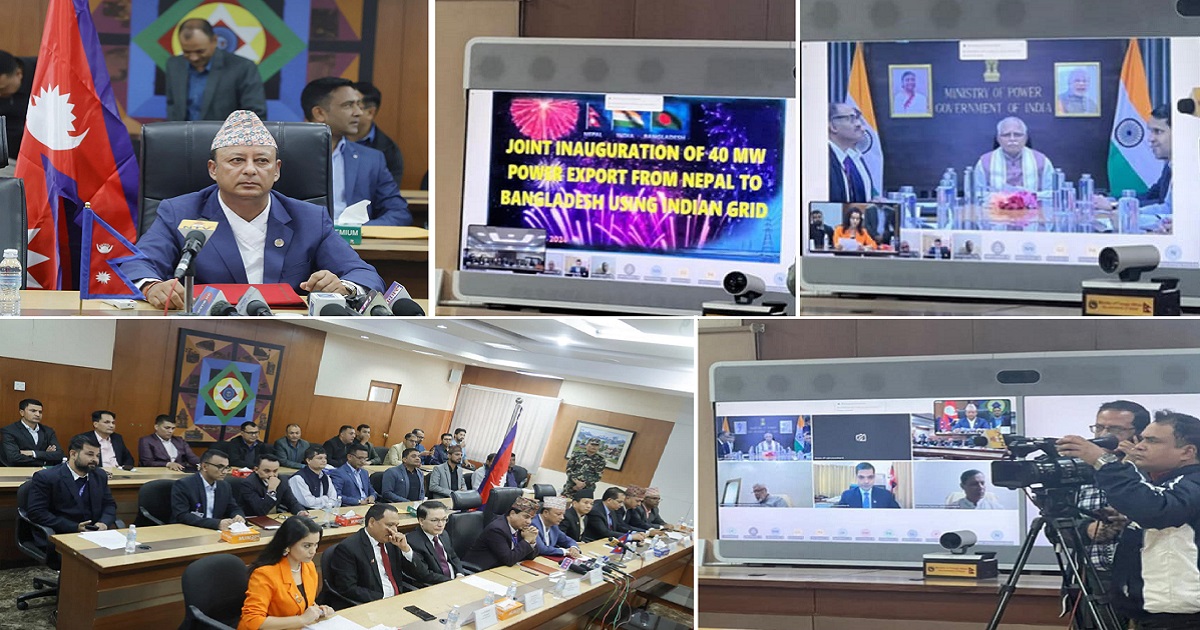
Kathmandu: Nepal has marked a historic milestone in its energy sector with the formal initiation of exporting 40 MW of electricity to Bangladesh through India’s transmission grid. The export agreement, set to continue for the next five years during the wet season, symbolizes a significant step toward regional energy collaboration and integration.
The inauguration ceremony took place on Friday at the Ministry of Foreign Affairs in Singha Durbar. The event was graced by Nepal’s Minister for Energy, Water Resources, and Irrigation, Deepak Khadka, with virtual participation from India’s Minister of Power, Manohar Lal Khattar, and Bangladesh’s Adviser to the Ministry of Power, Energy, and Mineral Resources, Muhammad Fouzul Kabir Khan.

Speaking at the event, Minister Khadka expressed pride in Nepal’s first-ever electricity export to Bangladesh. He highlighted that this initiative not only bolsters Nepal’s energy export ambitions but also contributes significantly to the energy security of South Asia. Echoing his sentiments, the Indian and Bangladeshi officials emphasized that the agreement marked the beginning of a robust collaboration aimed at addressing the region’s energy demands collectively.
The export of electricity from Nepal to Bangladesh is governed by a tripartite agreement signed on October 3, 2024 (Ashwin 17). The pact involves the Nepal Electricity Authority (NEA), Bangladesh Power Development Board (BPDB), and NTPC Vidyut Vyapar Nigam (NVVN) of India. Under the agreement, the NEA will supply 40 MW of electricity to Bangladesh for six months annually (June 15–November 15) over five years.

This electricity export is priced at NPR 8.64 per unit (USD 6.40 cents). Bangladesh will bear the wheeling charges for using India’s transmission infrastructure, specifically the 400 kV Baharampur (India)–Bheramara (Bangladesh) transmission line.
Nepal’s electricity will be supplied from the 24 MW Trishuli and 22 MW Chilime hydropower projects. These projects have already secured approval to export electricity to India, ensuring compliance with the regulatory framework required for the current arrangement.
For the export, a meter installed in Muzaffarpur, India, will monitor the power flow and facilitate billing. Transmission losses will be shared between the involved parties: Nepal will cover losses up to Muzaffarpur, while Bangladesh will assume responsibility for losses incurred beyond Muzaffarpur to the Bangladeshi border.
The government of Nepal has ambitious energy plans to position the country as a regional hydropower hub. By 2035, Nepal aims to generate 28,500 MW of electricity, with 15,000 MW allocated for export—10,000 MW to India and 5,000 MW to Bangladesh.
The export of electricity to Bangladesh, which totals approximately 144 million units annually, reflects Nepal’s commitment to advancing its energy sector and fostering regional cooperation. While initial plans to finalize the agreement in July 2024 (Shrawan 13) were delayed due to political changes in Bangladesh, the efforts of the interim government ensured its eventual materialization.
This achievement underscores Nepal’s growing role in South Asia’s energy dynamics and sets a strong foundation for future collaborations aimed at ensuring sustainable energy security in the region.